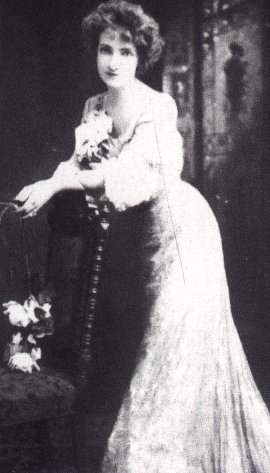Jessie Bonstelle (Jessie Bonstelle)

After the death of her parents in 1890, Jessie Bonstelle went to New York City, and in 1891 she joined the company of Fanny Janauschek, with whom she toured for a season. In 1892 she worked as an understudy and chorus member in Augustin Daly’s company, but the season left her exhausted. However, in 1893 she married the actor Alexander Hamilton Stuart, who was twenty years older than her[2] and Janauschek’s leading man. Happily married, together they worked in Philadelphia’s Forepaugh Stock Company for two years, before moving to Rochester, where Bonstelle played various roles and became an established leading lady. She was the leading lady of Philadelphia’s Standard Stock Company during the 1898–99 season. Stuart died in 1911; Bonstelle would never remarry. Jessie Bonstelle performed in three productions on Broadway, including Elizabeth Jordan’s The Lady from Oklahoma, which Bonstelle herself produced in 1913. Her acting received mixed or poor reception from New York Times critics, and according to some she “lacked creative depth”. In 1899, while playing with the Biancke Sisters, Bonstelle produced Heimat by Hermann Sudermann. This was its first performance in the United States, and only the second in English. Later she received a letter from Sudermann in which he thanked her for performing his work. Her career as a manager and director began around 1900 when Jacob J. Shubert offered her the management of a stock company in Rochester. This company, the Lyceum stock company, based at Rochester’s Lyceum Theater, included some prominent actors and future stars, such as Orrin Johnson, Margaret Wycherly and Charles Hutchison.
Jessie Bonstelle spent the next five years managing, directing and acting there, but also appeared from time to time in Philadelphia and toured at least once in Canada. Moreover, she occasionally directed for the Shuberts in New York, and was associated with Frederick Freeman Proctor’s 125th Street Theater in Harlem. Bonstelle said that her dedication was partly inspired by the death of Janauschek in 1904, realizing that what she did for the theater was lasting. From 1906 she managed stock companies at the Star Theater in Buffalo, and from 1910 also at Detroit’s Garrick Theater, moving weekly between the two cities. She usually put on plays which had recently been successful on Broadway, but not those which she saw as immoral. The most popular production she directed was an adaptation of Louisa May Alcott’s Little Women by Marian de Forest. Bonstelle researched the play herself, traveling to Boston to view personal papers provided by Alcott’s family and talking to her friends. The production toured nationally in 1911, with four companies performing in different places at the same time, and had a “successful and lengthy run” on Broadway in 1912. It was also performed in London after World War I. From 1912 to 1917 she was a director at the Northampton Municipal Theater in Massachusetts.
Jessie Bonstelle sold her stake in the Garrick Theater in 1924. She and her company founded the Bonstelle Playhouse in Detroit, which opened on January 1, 1925. Backed by a syndicate led by a patron of hers, she bought a former synagogue on Woodward Avenue, Temple Beth El, for $500,000 and commissioned C. Howard Crane to renovate it. At first she carried on producing mostly Broadway-style plays. However, the company did perform classics, including modern-dress productions of Romeo and Juliet in 1926 and Hamlet in 1927, among the first to put on such performances. In February 1928 Bonstelle began a campaign to gain community support for the theater. A fund of over $200,000 was raised by donations from the public and Bonstelle made an agreement with local authorities to make the playhouse the city’s unofficial premier theater. Later that year the group became known as the Detroit Civic Theater. In her plan for the theater she emphasized the importance of providing the public with the best drama, including both classics and modern works, and improving young people’s knowledge of dramatic literature. Funded by public subscription, it had ticket prices as low as $1.50. Performances included works by Shakespeare, Henrik Ibsen and Richard Brinsley Sheridan. The theater also played a religious role. Bonstelle used it in an effort to improve understanding and co-operation between the church and the theater, holding multi-denominational religious services there during Lent, and she stated that her plays, while avoiding being preachy, were intended to have a positive moral influence on the audience. Local clergy publicly praised her work with the theater.
In June 1932 Jessie Bonstelle went to Hollywood; possible reasons include a desire to direct films, to found an acting school, or to explore the possibility of a new stock company. She returned to Detroit after falling ill and learning she had cancer. There she began a campaign to keep open the Civic Theatre, which was adversely affected by the Great Depression, but became seriously ill. Aided by her secretary, she continued to campaign for and run the theater until her death on October 14, 1932, when she suffered a heart attack at the home of relatives in Detroit. On October 16 her body lay in state at the theater and the New York Times reported that twenty-five thousand people went to see her bier. A memorial service was held there which thousands attended and at which mayor Frank Murphy spoke. She was buried in Rochester next to her husband.
Born
- January, 01, 1970
- USA
- Greece, New York
Died
- October, 10, 1932
- USA
- Detroit, Michigan
Cause of Death
- heart attack
Cemetery
- Mount Hope Cemetery
- Rochester, New York
- USA



